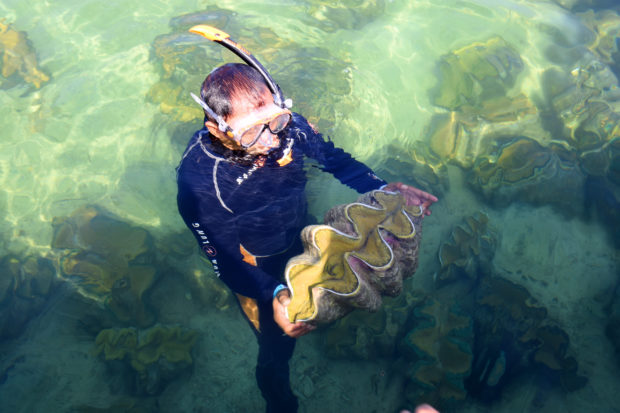Giant clams up for adoption

‘CULTURED TAKLOBO’ Giant clams, locally known as “taklobo,” are cultured in waters off Silaqui Island. WILLIE LOMIBAO
BOLINAO, Pangasinan — Be a foster parent to an endangered clam and help the environment.
For P200 to P400, you can adopt a baby giant clam at a marine center here, but you can’t take it home.
The adopted clam gets named by the parent and released in a special section of the country’s largest giant clam ocean nursery off Silaqui Island in Pangasinan province.
The marine laboratory of the University of the Philippines’ Marine Science Institute (UPMSI) here conceptualized the adoption program to draw support for giant clam conservation.
In the early 1980s, Edgardo Gomez, UPMSI founder and former director, started the giant-clam culture and restocking efforts through an Australian Center for International Agricultural Research-funded project.
Eight of the existing giant clam species in the world are found in the Philippines. Six are being cultured at the marine biology center here. These include the Tridacna gigas, Hippopus hippopus, Tridacna derasa, Tridacna squamosa, Tridacna maxima and Tridacna crocea.
Giant clams are endangered species, especially T. gigas, locally known as “taklobo.”
Because they live on coral reefs, the bivalves face the same threats that affect reefs, including overfishing, habitat destruction and pollution, said Cecilia Conaco, UPMSI Bolinao Marine Laboratory (BML) deputy director.
Julio Curiano Jr., BML administrative aide who oversees ocean nursery maintenance and stock enhancement, said poaching used to be a problem, too.
But that has been minimized after the Bolinao municipal council declared this town the “giant clam capital of the Philippines,” Curiano said.
“After almost four decades, we now have the largest population of giant clams, specifically,
T. gigas, at the Silaqui ocean nursery,” he said.
Donations to the program go to giant clam care, culture and research, Conaco said.
Only juvenile clams, aged 1 to 4, have been put up for adoption. Parents pay P200 for year-old clams, P300 for up to 3-year-olds, and P400 for 4-year-olds.
The foster parents receive an adoption kit with a certificate of adoption and a picture with their clam baby.
The adopted clams will be returned to the ocean nursery under the care of BML, which provides regular updates on their growth.














